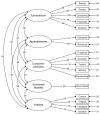Integrating prospective longitudinal data: modeling personality and health in the Terman Life Cycle and Hawaii Longitudinal Studies
- PMID: 23231689
- PMCID: PMC3758911
- DOI: 10.1037/a0030874
Integrating prospective longitudinal data: modeling personality and health in the Terman Life Cycle and Hawaii Longitudinal Studies
Abstract
The present study used a collaborative framework to integrate 2 long-term prospective studies: the Terman Life Cycle Study and the Hawaii Personality and Health Longitudinal Study. Within a 5-factor personality-trait framework, teacher assessments of child personality were rationally and empirically aligned to establish similar factor structures across samples. Comparable items related to adult self-rated health, education, and alcohol use were harmonized, and data were pooled on harmonized items. A structural model was estimated as a multigroup analysis. Harmonized child personality factors were then used to examine markers of physiological dysfunction in the Hawaii sample and mortality risk in the Terman sample. Harmonized conscientiousness predicted less physiological dysfunction in the Hawaii sample and lower mortality risk in the Terman sample. These results illustrate how collaborative, integrative work with multiple samples offers the exciting possibility that samples from different cohorts and ages can be linked together to directly test life span theories of personality and health.
(PsycINFO Database Record (c) 2014 APA, all rights reserved).
Figures




Comment in
-
Understanding the role of conscientiousness in healthy aging: where does the brain come in?Dev Psychol. 2014 May;50(5):1465-9. doi: 10.1037/a0036152. Dev Psychol. 2014. PMID: 24773108 Free PMC article.
References
-
- Bath PA, Deeg D, Poppelaars J. The harmonisation of longitudinal data: a case study using data from cohort studies in The Netherlands and the United Kingdom. Ageing & Society. 2010;30:1419–1437. doi: 10.1017/S0144686X1000070X. - DOI
-
- Christensen AJ, Ehlers SL, Wiebe JS, Moran PJ, Raichle K, Ferneyhough K, Lawton WJ. Patient personality and mortality: A 4-year prospective examination of chronic renal insufficiency. Health Psychology. 2002;21:315–320. - PubMed
-
- Cohn LD, Becker BJ. How meta-analysis increases statistical power. Psychological Methods. 2003;8:243–253. - PubMed
-
- Cooper R, Hardy R, Sayer AA, Ben-Shlomo Y, Birnie K, Cooper C, Kuh D. Age and gender differences in physical capability levels from mid-life onwards: The harmonisation and meta-analysis of data from eight UK cohort studies. PLOS One. 2011;6(11) doi: 10.1371/journal.pone.0027899. - DOI - PMC - PubMed
Publication types
MeSH terms
Grants and funding
LinkOut - more resources
Full Text Sources
Other Literature Sources

